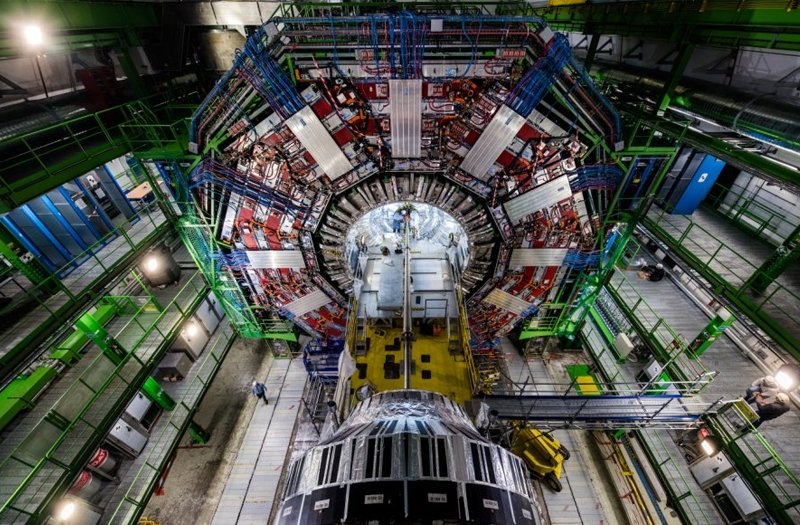What are the basic building blocks of our cosmos, and how do they interact? What happens at the smallest levels, and what hidden potential lies therein? How did our universe evolve, and what may the future hold? Particle physics research seeks that knowledge.
Scientists supported by the U.S. Department of Energy tackle these fundamental mysteries at universities and national labs across the country. They build state-of-the-art experiments that yield incredible discoveries and achievements. Along the way, they create new technologies, applications, and a highly trained workforce.
In the past, these technologies have found uses in areas as diverse as consumer electronics and medicine. When J. J. Thomson discovered the electron in 1897, few could imagine that one day life might largely revolve around devices built around it. When accelerator magnets were engineered to power the discovery of new particles, few foresaw their spinoff to new life-saving roles in MRI machines and cancer treatment. While today’s basic research delves into the fundamentals of our cosmos, it too may reveal knowledge that we will build on in tomorrow’s breakthroughs.
Perhaps the most well-known physics discovery of the past decade was that of the Higgs boson. It’s a long sought after particle that helps give rise to much of the mass in the universe. Hundreds of scientists at DOE labs and universities were part of the international teams that co-discovered the particle in 2012. Scientists have since learned much about how the Higgs boson lives, decays, and interacts with other particles. U.S. researchers were also instrumental in building the accelerator technology that made the intense high-energy beams of particles. They’re now making upgrades to the Large Hadron Collider’s particle accelerators and detectors, building innovative equipment and setting world records along the way.
In the U.S., particle physicists have also built on and expanded prior knowledge. Earlier this year, the Muon g-2 experiment at Fermilab provided further proof of an anomaly discovered 20 years ago at Brookhaven Lab. Researchers found that muons (the heavier cousins of electrons) behave in a way that scientists’ best theory does not predict—possibly because of new subatomic particles or forces at work.
Another class of particles known as neutrinos also display odd properties that hint at new physics. Researchers want to figure out whether these particles were key players in how our universe evolved, particularly if they’re the reason matter exists at all. The recent operation at CERN of a house-sized neutrino detector called ProtoDUNE successfully demonstrated the novel technology needed to help answer that question. Together with our international partners, we will use it to build the Deep Underground Neutrino Experiment here in the U.S. It’s a project made possible by the world’s most intense high-energy neutrino beam.
Researchers also gather more clues on the nature of dark matter, which makes up most of the mass in the universe. Using a gigantic, ultrasensitive camera developed at our national labs, the Dark Energy Survey produced the largest dark matter maps of the cosmos. A suite of current and upcoming experiments – including ADMX, DESI, the Vera Rubin Observatory, LZ and SuperCDMS – is poised to reveal dark matter’s secrets through direct detection and further mapping of matter. These maps of the celestial distribution of matter also help us understand the properties of the mysterious dark energy responsible for the accelerated expansion of the universe.
Our national labs also use their expertise in the quantum world to make important strides in quantum information science. The launch of the National Quantum Initiative has emphasized the importance of QIS to the nation’s cybersecurity and economic competitiveness. Scientists, engineers, and technicians at five new national quantum centers are working to build everything from quantum sensors to computers. They implement particle accelerator technologies and new computing algorithms while training a quantum workforce. A crucial step on the way to a viable quantum internet, DOE-funded researchers even made the first demonstration of sustained high-fidelity quantum teleportation.
While used in particle physics to smash particles together, accelerator technology also has applications in medicine, energy, national security, and materials science. In medicine alone, accelerators are used in imaging devices, radiation treatment for cancer, and X-ray beams to develop more effective drugs. Investments in accelerator research improve our current facilities as well as pursue advances that could result in new technologies. For example, laser-driven plasma wake field technology may be able to make the length of an accelerator 2,000 times smaller than today’s machines. Our accelerator stewardship program helps make this technology more widely available to science and industry.
Applications for the new knowledge gained by basic physics research are broad and transform society, yet are difficult to predict. They go hand-in-hand with answering one of our most fundamental questions: How does this universe work?
The Office of Science of the US Department of Energy is the single largest supporter of basic research in the physical sciences in the United States and is working to address some of the most pressing challenges of our time. For more information please visit science.energy.gov.


